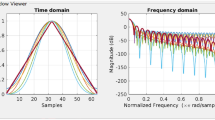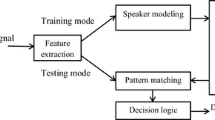Abstract
In this work the linear prediction (LP) residual is processed in spectral and cepstral domains to model the speaker-specific excitation information. In the spectral domain, the excitation energy information is modeled from subband energies (SBE). The excitation periodicity information is modeled by power differences of spectrum in subband (PDSS) measure. This work carries some refinements in the existing methods of extracting SBE and PDSS by exploiting the nature of the excitation spectrum. The SBE and PDSS values are computed from mel warped residual subband spectrum and called as residual mel subband energies (R-MSE) and mel power differences of subband spectra (M-PDSS), respectively. The different speaker recognition studies performed using NIST-99 and NIST-03 databases demonstrate that R-MSE and M-PDSS features represent good speaker information. It is also demonstrated that the excitation energy information can be better modeled in the cepstral domain by residual mel frequency cepstral coefficients (R-MFCC). Furhter, the evidences provided by M-PDSS and R-MFCC features are different and combine well and provides improved recognition performance. The combined evidence from M-PDSS and R-MFCC together with the vocal tract information further improves the performance. Finally, a comparative study on processing the LP residual in temporal, spectral and cepstral domains demonstrates that with a small compromise with the recognition performance, processing LP residual in spectral and cepstral domains provide compact and effective way of representing the excitation information, as compared to temporal processing.







Similar content being viewed by others
References
Atal, B. S. (1972). Automatic speaker recogntion based on pitch contours. The Journal of the Acoustical Society of America, 52(6), 1687–1697.
Atal, B. S. (1974). Effetiveness of linear prediction characterstics of the speech wave for automatic speaker identification and verification. The Journal of the Acoustical Society of America, 55(6), 1304–1312.
Atal, B. S. (1976). Automatic recognition of speakers from their voices. Proceedings of the IEEE, 64(4), 460–475.
Campbell, J. P, Jr. (1997). Speaker recognition: A tutorial. Proceedings of IEEE, 85(9), 1437–1462.
Chan, W. N., Zheng, N., & Lee, T. (2007). Discrimination power of vocal source and vocal tract related features for speaker segmentations. IEEE Transactions on Audio, Speech and Signal Processing, 15(6), 1884–1892.
Cohen, L. (1995). Time-Frequency Analysis: Theory and Application, Series Signal Processing Series. Englewood Cliffs: Prentice Hall.
Davis, S. B., & Mermelstein, P. (1980). Comparison of parametric representations for monosyllabic word recognition in continuously spoken sentences. IEEE Transactions on Acoustics, Speech and Signal Processing, 28(28), 357–366.
Deller, J., Hansen, J., & Proakis, J. G. (2000). Discrete-time processing of speech signal (2nd ed.). New York: IEEE Press.
Duda, R. O., & Hart, P. E. (2001). Pattern classification (2nd ed.). New York: Wiley.
Feustel, T. C., Velius, G. A., & Logan, R. J. (1989). Human and machine performance on speaker identity verification. Speech Technology, pp. 169–170
Furui, S. (1981). Cepstral analysis technique for automatic speaker verification. IEEE Transactions on Acoustics, Speech and Signal Processing, 29(2), 254–272.
Gray, A. H, Jr, & Markel, J. D. (1974). A spectral-flatness measure for studying the autocorrelation method of linear prediction of speech analysis. IEEE Transactions on Acoustic Speech and Signal Processing, ASSP–22(3), 207–217.
Gudnanson, J., & Brookes, M. (2008). Voice source cepstrum coefficients for speaker identification. Proceedings of the International Conference on Acoustic Speech and Signal Processing. (pp. 4821–4824). Nevada, USA:Las Vegas.
Haeb-Umbach, R. (1999). Investigation on inter-speaker variability in the feature space. Proceedings of the international conference on Acoustical Speech and Signal Processing (ICASSP), Phoenix, AZ, (pp. 397–400).
Hall, J. J., & Srihari, S. N. (1994). decision combination in multiple classifier systems. IEEE Transactions on Pattern Analysis and Machine intelligence, 16, 66–75.
Hayakawa, S., Takeda, K., & Itakura, F. (1997). Speaker identification using harmonic structure of lp-residual spectrum. Biometric personal Aunthentification, Lecture notes, Springer, Berlin, 1206, 253–260.
Makhoul, J. (1975). Linear prediction: A tutorial review. Proceedings of the IEEE, 63(4), 561–580.
Martin, A., Doddington, G., Kamm, T., Ordowski, M., & Przybocki, M. (1997). The DET curve in assessment of detection task performance. Proceedings of the Europe Conference on Speech Communication Technology, Rhodes, Greece, vol. 4, pp. 1895–1898.
Mary, L., & Yegnanarayana, B. (2008). Extraction and representation of prosodic features for language and speaker recognition. Speech Communication, 50, 782–796.
Mashao, D. J., & Skosan, M. (2006). Combining classifier decisions for robust speaker identification. Pattern Recognition, 39, 147–155.
Murthy, K. S. R., & Yegnanarayana, B. (2008). Epoch extraction from speech signal. IEEE Transactions on Audio Speech and Language Processing, 16(8), 1602–1613.
Murthy, K. S. R., & Yegnanarayana, B. (2009). Characterization of glottal activity from speech signal. IEEE Signal Processing Letter, 16(6), 469–472.
Murty, K. S. R., Prasanna, S. R. M., & Yegnanarayana, B. (2004). Speaker specific information from residual phase. Proceedings of ther international of conference on signal processing and communication (SPCOM).
Murty, K. S. R., & Yegnanarayana, B. (2006). Combining evidence from residual phase and MFCC features for speaker recognition. IEEE Signal Processing Letters, 13(1), 52–55.
Nist speaker recognition evaluation plan (2003). In: Proceedings of NIST Speaker Recognition Workshop, College Park, MD.
Oppenhiem, A. V., & Schafer, R. W. (1975). Digital signal processing. Englewood Cliffs, NJ: Prentice Hall.
Pati, D., & Prasanna, S. R. M. (2008). Non-parametric vector quantization of excitation source information for speaker recognition. In Proceedings of the IEEE TENCON, pp. 1–4.
Pati, D., & Prasanna, S. R. M. (2010). Speaker information from subband energies of linear prediction residual. Proceedings of the NCC, 2010, 1–4.
Pati, D., & Prasanna, S. R. M. (2011). Subsegmental, segmental and suprasegmental processing of linear prediction residual for speaker information. International Journal of Speech Technology, 14(1), 49–63.
Plumpe, M. D., Quatieri, T. F., & Reynolds, D. A. (1999). Modelling of glottal flow derivative waveform with application to speaker identification. IEEE Transactions on Speech and Audio Processing, 7(5), 569–586.
Prasanna, S. R. M., Gupta, C. S., & Yegnanarayana, B. (2006). Extraction of speaker-specific excitation information from linear prediction residual of speech. Speech Communication, 48, 1243–1261.
Pruzansky, S., & Mathews, M. V. (1964). Talker-Recognition procedure based on Analysis of Variance. The Journal of the Acoustical Society of America, 36(11), 2041–2047.
Przybocky, M., & Martin, A. (2000). The NIST-1999 speaker recognition evaluation- An overview. Digital signal processing, 10, 1–18.
Reynolds, D. A. (1994). Experimental evaluation of features for robust speaker identification. IEEE Transactions on Speech and Audio Processing, 2(4), 639–643.
Reynolds, D. A. (1995). Speaker identification and verification using gaussian mixture speaker models. Speech Communication, 17, 91–108.
Reynolds, D. A., & Rose, R. C. (1995). Robust text-independent speaker identification using gaussian mixture speaker models. IEEE Transactions on Speech and Audio Processing, 3(1), 4–17.
Thevenaz, P., & Hugli, H. (1995). Usefulness of the LPC-residue in text-independent speaker verification. Speech Communication, 17, 145–157.
Wang, N., Ching, P. C., & Lee, T. (2009). Exploration of vocal excitation modulation features for speaker recognition. Proceedings of INTERSPEECH-09, (pp. 892–895). Brighton UK.
Wolf, J. J. (1972). Efficient acoustic parameters for speaker recognition. Journal of the Acoustical Society of America, 51(2), 2044–2055.
Yegnanarayana, B., Reddy, K. S., & Kishore, S. P. (May 2001). Source and systsem feature for speaker recognition using AANN Models. Proceedings of IEEE International Conference Acoustic Speech and Signal Processing. (pp. 409–412) Salt Lake City, UT, USA.
Yegnenarayana, B., & Murthy, K. S. R. (2009). Event based instanteneous fundamental frequency estimation from speech signals. IEEE Transaction Audio Speech and Language Processing, 17(4), 614–624.
Zheng, N., Lee, T., & Ching, P. C. (2007). Integration of complimentary acoustic features for speaker recognition. IEEESignal Processing Letter, 14(3), 181–184.
Author information
Authors and Affiliations
Corresponding author
Rights and permissions
About this article
Cite this article
Pati, D., Prasanna, S.R.M. Processing of linear prediction residual in spectral and cepstral domains for speaker information. Int J Speech Technol 18, 333–350 (2015). https://doi.org/10.1007/s10772-015-9273-9
Received:
Accepted:
Published:
Issue Date:
DOI: https://doi.org/10.1007/s10772-015-9273-9




